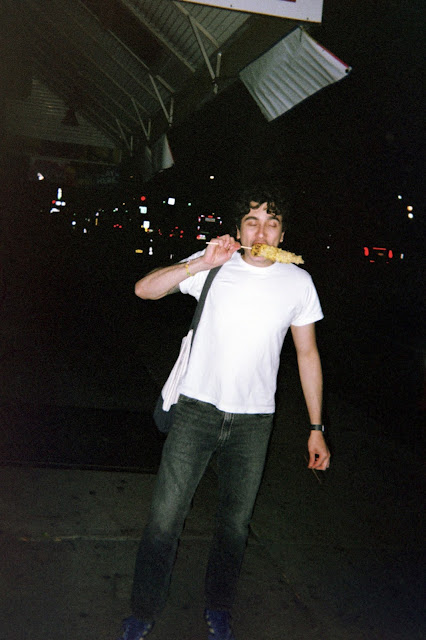The cloves closest to the core of the head are not fully articulated. Cooking in the half-light is a practice of tactile discernment, thumbing the cloves as they decrease sequentially in size. The first rain of fall spits against the windows, but the door to the balcony is left ajar. Later, one might see a strip of water accumulated there.
Oil is heating in a skillet on the cooktop and water approaches a boil. As she cooks, she thinks back to the drive over the airport tarmac last night. As she sat on the bus, a different model this time, the phrases she'd written about this same drive resounded in her mind. She'd written her own narration to this drive, and she recognized its exactitude as it rang out to describe the same sights.
As she cooks tonight, she's turning these phrases over already in her mind: "first rain of fall" and "the cloves are not fully articulated" as she moves about the small kitchen. Thinking about "she" and "our girl".
The story she wrote is out for first reading with two of her most trusted friends. When she wrote it, it had felt like a potent record of something that needed to be captured. But now, the line between recollection and fiction has become significantly blurred. Memory and feeling turn out to be incredibly fickle.
"She" is obviously a deflection. A way to say what she's thinking without explicitly claiming it as hers. These days, she feels as though she is hiding, cloaking herself in solitude to avoid being caught out.
She feels as though she is straddling two large pieces of ice, floating in a frigid ocean. They slip and jostle, threatening to upset her footing. She feels exhausted by the fluctuations in her own hopes and perturbations. She cannot fathom how or why the people around her put up with her vicissitudes. She wonders if it would be easier to cut them loose, to allow them to find stability elsewhere. Perhaps that would show real mercy.
In the morning, the sky had been blue with trailing wisps dispersed, but in the mid-afternoon the sycamores began to flail with an almighty wind. Then approached a purplish stand of clouds from the north and just at the crux of darkness rain began to fall.
In the afternoon, she'd found a thick volume in a book shop. Annuaire de la Jeunesse: Education et Instruction, published 1914. The pages were crumbling, in no fit state to be left on a shop shelf. She'd opened the book carefully. It seemed to be a catalog dedicated to schools in and around France. "Instruction of English or German begins in grade six, but Spanish is integrated into instruction from grade one." "The school is half-boarding and is accepting new pupils."
The book was shelved just feet away from a pocket-sized Inferno, in its original Italian, bound in red cotton. No distinction had been made as to their relative literary merits, to their relative truths or untruths.
She was not an altogether sheepish recipient of the past, in fact she often occupied herself by trying to imagine places in their states of antiquity. Like holding a photo transparency over the present topography, it was a practice that required accepting a certain level of dissonance.
She closed the Annuaire gingerly. Leaning in to read a quote in small print on the cover, her eyes strayed to the upper left hand corner. Previously unnoticed, she saw there an inscription in faded brown ink, Fernand Démousseau. The F had been carefully serifed and the tail of the final u curved around itself to become a self-assured diagonal. At one time, the ink had been raised, wet and mutable. A warm hand had carefully, expertly drawn a pen across the gray-green paper cover.
Besides the sheer humanity of the name written on the page, she had been struck by the absolute beauty of the script. In its regularity, it was nearly as perfect as the mechanically printed text on the cover. But in the tall vertical stroke of the D, it was possible to see where the nib had splayed, drawing ink unevenly.
Years ago, she'd happened upon a resplendent Caravaggio portrait of a man in a red cap. It was in a dark corner of a museum, and she'd been captivated by the beauty of the sitter. She had found herself leaning in towards the painting, willing the man to tilt his head in her direction, to bestow his depths upon her. When she had finally left the painting, she did so with dismay, feeling as though she was leaving behind a particularly beautiful prospect, sighted from across a room.
The signature on the book had left her with this same sense of lingering pleasure. The grace of its curves, the uniformity of its lines, belied a slight wrist and long, elegant fingers. Just like Caravaggio's sitter, this imagined signer had his basis in truth. There was a Fernand who had really lived to ink his name.
And yet the Fernand that she encountered, as with the man in the painting, was someone else entirely. He was someone of her own invention, a product of the intervening years, which had erased fact and proffered figment instead.
But, so we are told, that is history. Neither truth nor fiction, but a cumulative record, imagined as much as it is lived.






